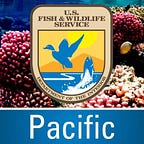Ha’ånen Litekyan: A Day to Remember
By: Jordan Akiyama, Public Affairs Specialist, U.S. Fish & Wildlife Service
In 2021, all across the nation families, are looking for ways to diversify their time together. Guam National Wildlife Refuge found their own way to reconnect people with the world outside their walls.
March was Mes CHamoru (CHamoru Month), and on March 27 the refuge and their community partners celebrated Ha’ånen Litekyan, or Ritidian Day.
“The goal of Ritidian Day was to celebrate CHamoru culture and heritage,” said Marybelle Quinata, a park ranger and education and outreach coordinator at the refuge. “At Ha’ånen Litekyan, we wanted to honor our storytelling and traditional knowledge of the plants and wildlife visitors can see. Though the pandemic has been a time of hardship around the world, it has also highlighted the importance of outdoor spaces, such as our national wildlife refuges and national historical parks, to the public.”
While Guam National Wildlife Refuge has celebrated Mes CHamoru in the past, the events of this year added a few challenges for the refuge team and their partners. Because Guam is still under COVID-19 restrictions, the team had to create activities that could still be engaging for families, but keep them feeling safe at the same time.
“Storytelling was my initial choice because listening to the CHamoru legends was my favorite part of my CHamoru class in school,” said Quinata. “In addition, a storytelling event is innately contactless, so it seemed like a natural fit as we transition back to hosting public programs under a pandemic. As a collective, our program partners for this event all agreed that we wanted it to be more interactive and fun than a standard outreach presentation.”
Teresita Perez, author of the book “CHamoru Legends: A Gathering of Stories” started off the event with a story from her book about the ko’ko’ and the hilitai. The hilitai (monitor lizard) can be seen throughout the Nature Trails within the refuge, while the ko’ko’ (Guam rail) is endangered and a large part of the refuge team’s conservation mission.
Quinata requested this story because it warns us about the dangers of selfishness and to embrace our mistakes and imperfections. Most stories passed down throughout time teach us lessons and dare us to be better; Quinata’s hope was to connect families, through their culture, to the natural environment and inspire them to protect their natural resources for present and future generations too.
The next activity planned for Ritidian Day was introducing visitors to one of the stars of the story, a real life ko’ko’ named Buenas. Accompanying Buenas was Guam Department of Agriculture biologist Anthony Tornito who explained the importance of Guams native birds and shared the updates on restoration efforts protect them. To help them connect with the story and create lasting memories of the day, families got to hold, pet, and take pictures with Buenas.
The day’s event concluded with a scavenger hunt for native plants and wildlife. Each item was labeled with their CHamoru name, while their importance to native wildlife and traditional medicinal uses were shared by the staff.
“My favorite memory was seeing all the kids and parents freely exploring the Nature Trails to find the plants and animals on the scavenger hunt,” said Quinata. “I loved that the kids were leading the way and that parents were really enjoying themselves too. The kids were so committed to finding a hilitai, even when we ran out of time.”
Ritidian Day was an exciting success, because it allowed families to enjoy a fun and safe day away from their homes. While the world searches for a new form of balance, communities that once relied heavily on inclusivity and interaction have struggled to find safe ways to come together. Guam National Wildlife Refuge is the perfect place to reestablish a relationship with history, nature and one another. As Quinata reflected on the day’s events, both her and the rest of the team realized how important the refuge and outdoor spaces were to their community.
“The impact of the pandemic has made people second-guess places where families and friends can feel safe while spending time together,” said Quinata. “We’re happy that the Ritidian Unit offers a safe and fun spaces for our community to get outside and appreciate Guam’s natural environment. We want to strengthen our bond as a community in order to take care of these places that are culturally important, as well as critical habitat for many of our island’s endangered species.”
The U.S. Fish and Wildlife Service works with others to conserve, protect, and enhance fish, wildlife, plants, and their habitats for the continuing benefit of the American people. For more information, connect with us through any of these social media channels at https://www.facebook.com/PacificIslandsFWS, www.flickr.com/photos/usfwspacific/, or www.twitter.com/USFWSPacific.
